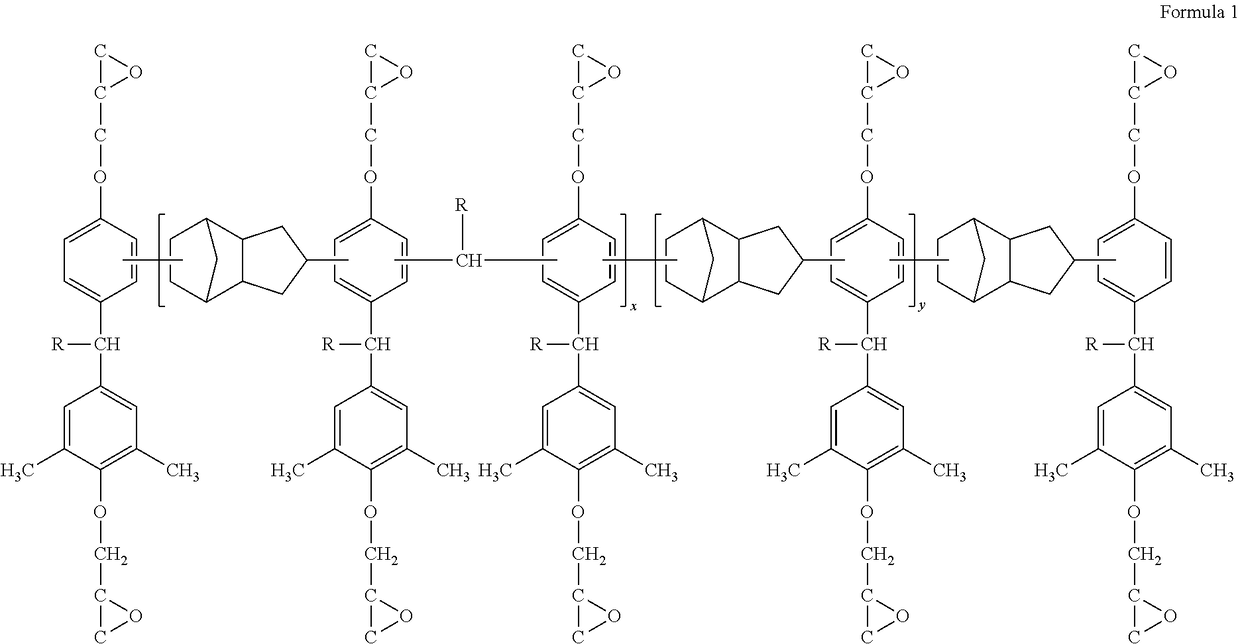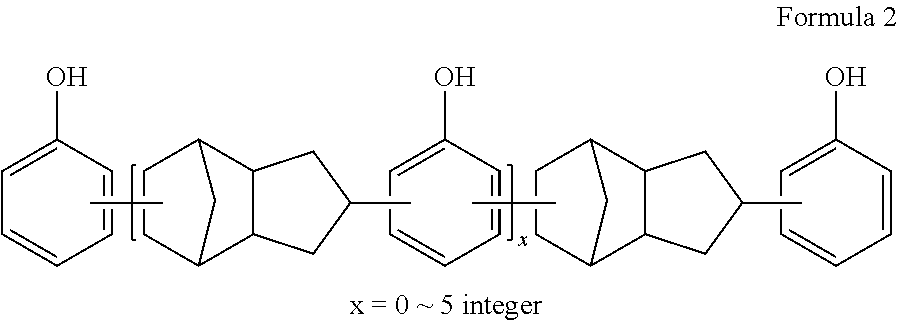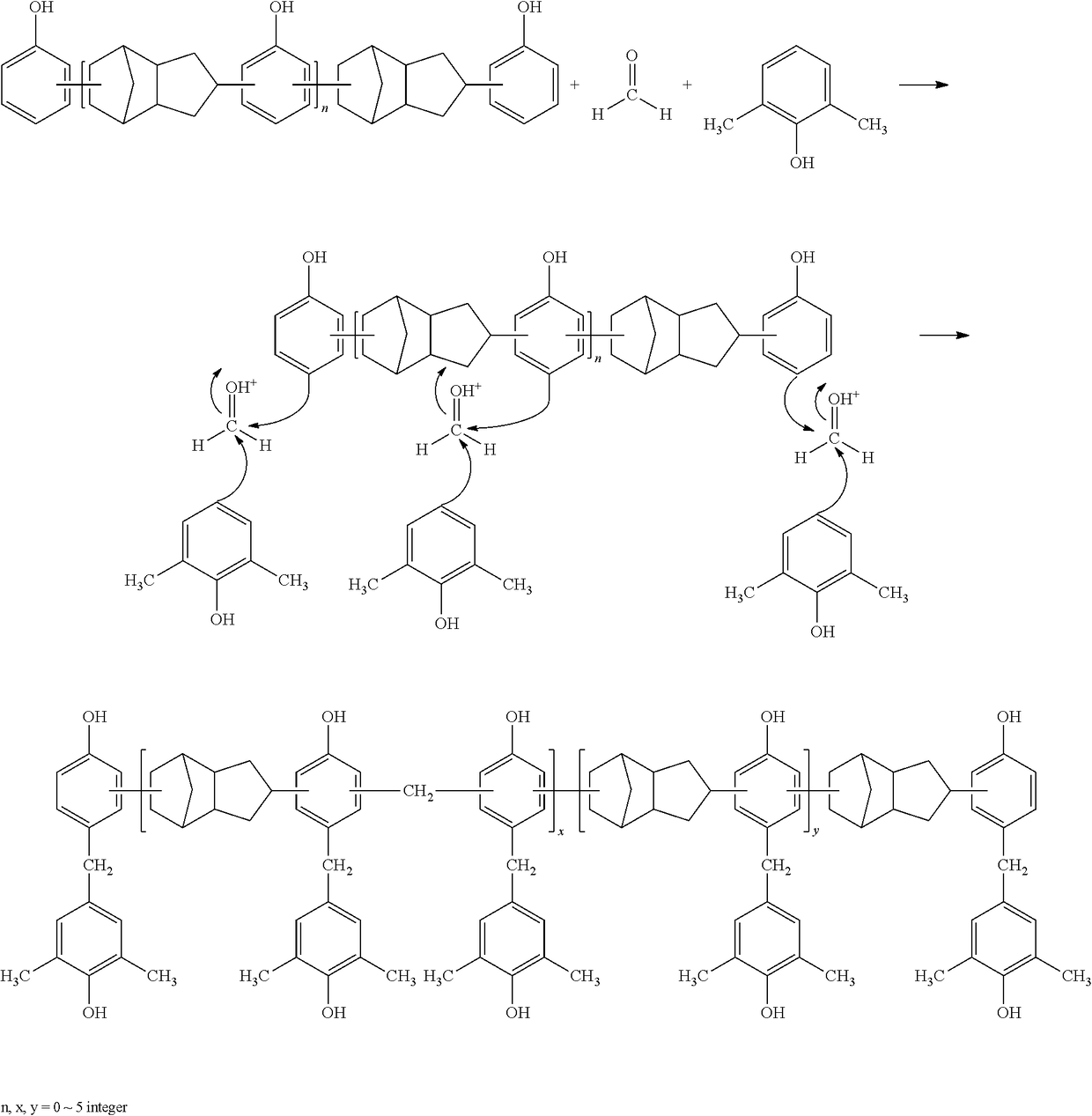Preparation and application of dicyclopentadiene-phenol and 2,6-dimethyl phenol copolymer epoxy resin
- Summary
- Abstract
- Description
- Claims
- Application Information
AI Technical Summary
Benefits of technology
Problems solved by technology
Method used
Image
Examples
embodiment a
f dicyclopentadiene phenol and 2,6-dimethyl phenol copolymer epoxy Resin A)
[0023]Mix and heat dicyclopentadiene phenol resin (Nan Ya Plastics Corporation, NPEH-772L, softening point 85° C.) 170 g (1 mole phenolic hydroxyl group), 2,6-dimethyl phenol 170 g, solvent methyl isobutyl ketone (MIBK) 30 g, catalyst methanesulfonic acid MSA 1.7 g to 107° C., react for 3.5 h after dropwise adding 23% formaldehyde solution 130 g at 107° C., and perform the ripening reaction for 1 h at 107° C. After the reaction, add 0.8 g 49.5% aqueous solution NaOH to neutralize till pH=6-7, heat to 140° C. for dehydration, and continuously heat to 185° C. and slowly reduce the vacuum degree to 5 torr. After the temperature and the vacuum degree reaches set value 185° C. and 5 torr, maintain the temperature and the vacuum degree for 1 h. Add the solvent methyl isobutyl ketone 550 g after cooling and vacuum breakage, stir for 60 min at 80° C., add water 50 g, stand for layering at 80° C., remove the saline la...
embodiment b
f dicyclopentadiene phenol and 2,6-dimethyl phenol copolymer epoxy Resin B)
[0025]Mix and heat dicyclopentadiene phenol resin (Nan Ya Plastics Corporation, NPEH-772L, softening point 110° C.) 180 g (1 mole phenolic hydroxyl group), 2,6-dimethyl phenol 170 g, solvent methyl isobutyl ketone (MIBK) 30 g, catalyst methanesulfonic acid MSA 1.7 g to 107° C., react for 3.5 h after dropwise adding 23% formaldehyde solution 130 g at 107° C., and perform the ripening reaction for 1 h at 107° C. After the reaction, add 0.8 g 49.5% aqueous solution NaOH to neutralize till pH=6-7, heat to 140° C. for dehydration, and continuously heat to 185° C. and slowly reduce the vacuum degree to 5 torr. After the temperature and the vacuum degree reaches set value 185° C. and 5 torr, maintain the temperature and the vacuum degree for 1 h. Add the solvent methyl isobutyl ketone 550 g after cooling and vacuum breakage, stir for 60 min at 80° C., add water 50 g, stand for layering at 80° C., remove the saline l...
comparable examples 1-3
[0030]Without use of the dicyclopentadiene phenol and 2,6-dimethyl phenol copolymer epoxy resin according to the present invention, the other epoxy resin with low dielectric constant is used as the comparable examples, the composition of which is given in Table 2. The benzaldehyde-phenol epoxy resin (Nan Ya Plastics Corporation NPPN-433) is used in the comparable example 1, the 2,6-dimethyl phenol phenolic aldehyde epoxy resin (Nan Ya Plastics Corporation NPPN-260) is used in the comparable example 2, and the dicyclopentadiene-phenol epoxy resin (Nan Ya Plastics Corporation NPPN-272H) is used in the comparable example 3.
TABLE 2Composition of varnish used and physical property ofglass fiber substrate prepared in comparable exampleComparableComparableComparableItemexample 1example 2example 3Dicyclopentadiene-phenol——100epoxy resin Nan Ya PlasticsCorporation NPPN-272HEEW270 g / eq2,6-dimethyl phenol formalde-—100—hyde epoxy resin Nan YaPlastics Corporation NPPN-260 EEW198 g / eqBenzaldehyd...
PUM
| Property | Measurement | Unit |
|---|---|---|
| Temperature | aaaaa | aaaaa |
| Temperature | aaaaa | aaaaa |
| Temperature | aaaaa | aaaaa |
Abstract
Description
Claims
Application Information
 Login to View More
Login to View More - R&D
- Intellectual Property
- Life Sciences
- Materials
- Tech Scout
- Unparalleled Data Quality
- Higher Quality Content
- 60% Fewer Hallucinations
Browse by: Latest US Patents, China's latest patents, Technical Efficacy Thesaurus, Application Domain, Technology Topic, Popular Technical Reports.
© 2025 PatSnap. All rights reserved.Legal|Privacy policy|Modern Slavery Act Transparency Statement|Sitemap|About US| Contact US: help@patsnap.com



